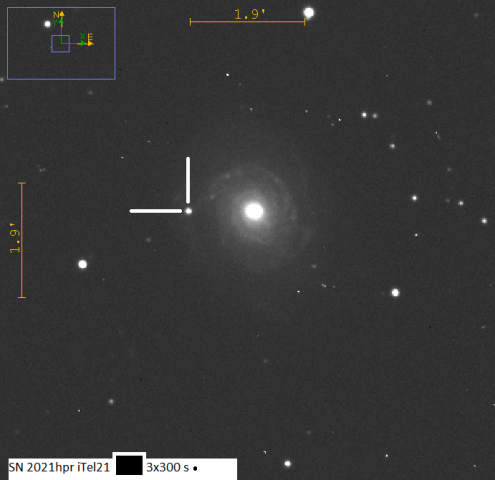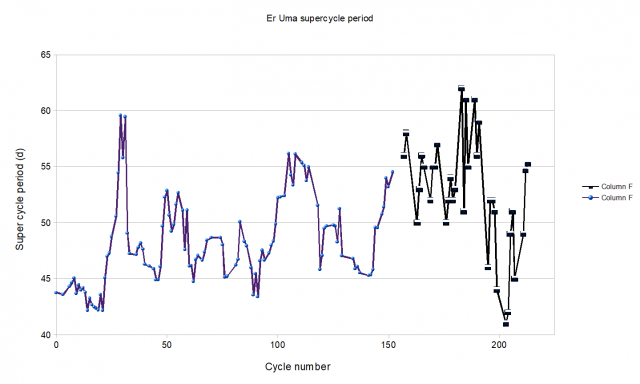Forum Replies Created
-
AuthorPosts
-
 Stewart John BeanParticipant
Stewart John BeanParticipantThe present superoutburst seems to have been recorded first by Graeme Coates and Tim Haymes on the evening of the 23rd June. This translates to a superoutburst period of 51 +-1 day which is right in the middle of the range of values from 45 to 55 days discussed in VSSC188.
Thanks again to Graeme and Tim and all other contributors.
This target is now really difficult and June has previously marked the end of the observing season. In October the whole cycle begins again with a possible superoutburst around Oct 1. Can this one be observed?
Stewart
 Stewart John BeanParticipant
Stewart John BeanParticipantI used iTEL 18 last night to get a time series. VPhot reports the V filter magnitude dropping from 13.15 to 13.3 over 13 minutes. The variation may be related to the orbital period of 90 min or the change in skyglow in the dusk sky. Going to repeat tonight but starting a bit later. Stewart
 Stewart John BeanParticipant
Stewart John BeanParticipantIts a difficult target right now!
 Stewart John BeanParticipant
Stewart John BeanParticipantKen Menzies (AAVSO) has helped me upload images with the clear filter as CV into the AAVSO database. All fit with the existing results from other observers so I seem to have done it right. Stewart
 Stewart John BeanParticipant
Stewart John BeanParticipantDefinitely in outburst and possibly this will trigger the superoutburst. The last superoutburst was recorded, at its brightest at 12.2 visual, by OJR (AAVSO) on 2459339. So we are ~50 days later right now. Could well brighten over the next day or two.
Stewart
 Stewart John BeanParticipant
Stewart John BeanParticipantER Uma was at quite dim last night at 15.0 V mag. It is also approaching time for the next superoutburst as the last one started around JD 2459338. With a super outburst period of 55 +_ 5 days, this minimum may be the last before a normal outburst triggers the superoutburst. A few extra observations in the next 5 days could capture the event nicely.
Thanks in advance.
Stewart
 Stewart John BeanParticipant
Stewart John BeanParticipant16.9 V mag on the early morning 20th May. Data is at AAVSO site. Stewart
 Stewart John BeanParticipant
Stewart John BeanParticipantIX Dra at 14.6 V mag last night (with distinct variations over 15 minutes) which is typical for superoutbursts. Timing is consistent with expectations as described in VSSC 187. Data is at the AAVSO site.
IX Dra does seem fairly well behaved around its 60.5 days super cycle period.
 Stewart John BeanParticipant
Stewart John BeanParticipantOnly 18.0 V filter last night ( New Mexico AAVSOnet) . Probably the minimum before the superoutburst.
 Stewart John BeanParticipant
Stewart John BeanParticipantThey look good to me. Variation of about 0.15 mag is about right for superhumps, i think. So it all fits.
Thanks , Stewart
 Stewart John BeanParticipant
Stewart John BeanParticipantContinues to look like a superoutburst. Stewart
 Stewart John BeanParticipant
Stewart John BeanParticipantV mag 12.4 and 12.88 would suggest a superoutburst has started about 53 days from the previous start.
Jose Ripero Osorio (AAVSO) also reports 12.2 on May 4th.
If anyone can collect time resolved photometry to record super humps that would be good.
Stewart
 Stewart John BeanParticipant
Stewart John BeanParticipantER Uma is expected to start a superoutburst shortly (due date May 5th) so if anyone can help with observations that would be great. ER Uma is a reasonably bright target when in outburst, at about V mag 13, and is high in the sky in the evenings during May. Yesterday it was down at Vmag 15 so that may have been the minimum before a rise to superoutburst.
Stewart
 Stewart John BeanParticipant
Stewart John BeanParticipantAccording to the recent trend of 60 days between superoutbursts, IX Dra is due to start its next outburst on May 9th – give or take a few days.
Last night it was at V mag 16.7 and the day before at 17.8 (AAVSO BSM-NM). So it may have one more normal outburst before the super starts.
All contributions welcome to try to capture the time of the next superoutburst.
Stewart
 Stewart John BeanParticipant
Stewart John BeanParticipantVphot estimates the SN to be at V mag 14.85
 Stewart John BeanParticipant
Stewart John BeanParticipant
This is an image from 2021-04-09 09:00:20 obtained from New Mexico using iTel 021. 3 x 300 s exposure in V filter.
 Stewart John BeanParticipant
Stewart John BeanParticipantJames DeYoung (USA) has uploaded three days of results – including superhumps starting at JD 2459285.5. So the outburst seems to have started at JD 2459285 giving a superoutburst period of 55.3 days since the last. This compares to 54.7 days for the previous period. So 55 days seems a good number to use for the next outburst although there may be an increasing trend as shown in the graph.
The next superoutburst may be around May 5th give or take a week.

 Stewart John BeanParticipant
Stewart John BeanParticipantER UMa was last reported to be at a low state at 14.8 visual from Hungary. So a superoutburst should happen soon, but, unlike IX Dra , each period varies by upto +_ 7 days from the last. Observations would be most welcome in the next week – howling gales permitting.
The stream of AAVSOnet images I have relied upon for ER Uma, IX Dra and RZ Lmi ( all UGER stars) has paused for some reason.
Thanks in advance
Stewart
 Stewart John BeanParticipant
Stewart John BeanParticipantNick, Excellent. I think your observation caught it on the rise to the outburst.
This fits with the recent average period between superoutbursts of 60.5 days.
Stewart
 Stewart John BeanParticipant
Stewart John BeanParticipantGary Poyner notes that Yutaka Maeda (Nagasaki, Japan) has reported the following:
DRA IX 2021 03 10.74591 146:c Mdy.VSOLJ outburst
I also just had 14.7 Vmag at 2021/03/11 11:26:17 from itel T11. This compares with 14.5 Vmag for the two previous superoutbursts so most probably a superoutburst.
If anyone has observations for the last few days they could help firm up on the time of the super-outburst’s start.
Stewart
-
AuthorPosts
